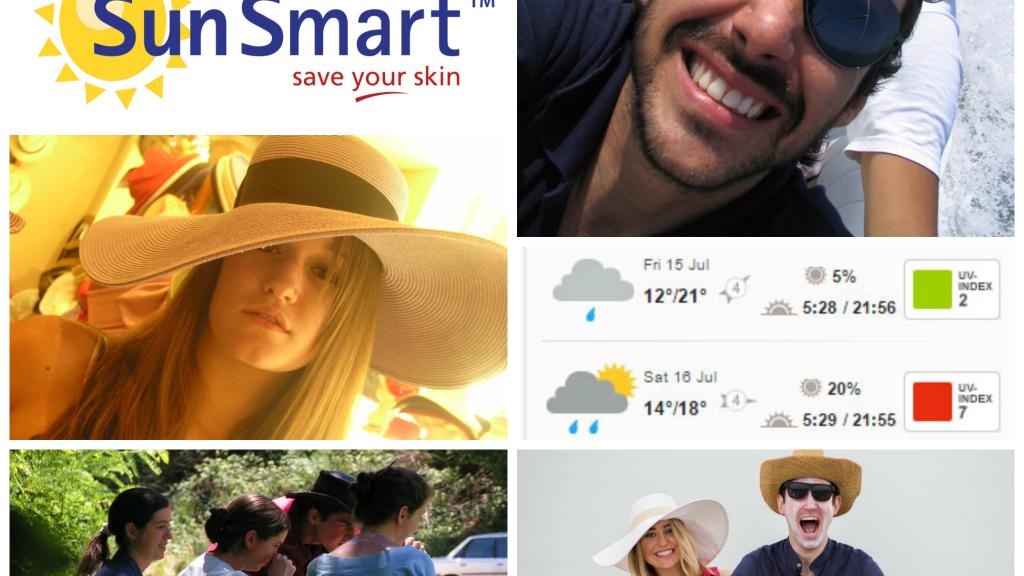
Staying SunSmart all year round
You probably protect your skin when on you go on holidays abroad or on really hot sunny days here at home. But that isn’t enough. When in Ireland get into the habit of protecting your skin every day from April to September, whatever the weather.
Even in spring and autumn, when the weather is still cool, UV levels can be high enough to cause damage and lead to skin cancer. With good protection against UV rays, most cases of skin cancer can be avoided.
Know your skin type and reduce your risk of skin cancer
[[{"fid":"5923","view_mode":"teaser","fields":{"format":"teaser","field_file_image_alt_text[und][0][value]":false,"field_file_image_title_text[und][0][value]":false},"type":"media","field_deltas":{"1":{"format":"teaser","field_file_image_alt_text[und][0][value]":false,"field_file_image_title_text[und][0][value]":false}},"link_text":null,"attributes":{"style":"float: right; margin: 2px;","class":"media-element file-teaser","data-delta":"1"}}]]Did you know that there are six different skin types? They range from white skin that burns and never tans to black skin. In Ireland 3 out of 4 people have skin types 1 or 2 which means their skin burns and does not tan or burns before it tans. This greatly increases their risk of skin cancer.
However, even if your skin type is brown or black, which makes it less likely to burn, it can still receive enough UV damage to increase skin cancer risk.
We have developed an interactive online quiz to help you determine your skin type so you can take proper precautions to protect your skin.
Avoiding sunbed use
[[{"fid":"7200","view_mode":"teaser","fields":{"format":"teaser","field_file_image_alt_text[und][0][value]":"Melanoma cancer survivor Shirley McEntee","field_file_image_title_text[und][0][value]":false},"type":"media","field_deltas":{"6":{"format":"teaser","field_file_image_alt_text[und][0][value]":"Melanoma cancer survivor Shirley McEntee","field_file_image_title_text[und][0][value]":false}},"link_text":null,"attributes":{"alt":"Melanoma cancer survivor Shirley McEntee","style":"float: right; margin: 2px;","class":"media-element file-teaser","data-delta":"6"}}]]
"I have lost a lot because of bloody sunbeds.”
- Shirley, 31
Shirley McEntee (right) was diagnosed with skin cancer at 31. She puts it down to sunbed use.
Shirley says that when she sees a sunbed she feels like smashing it. She was 31 when she was diagnosed with a malignant melanoma, which presented as a dark dot on her shoulder. At the time she wasn’t overly worried. “I thought with skin cancer they just cut it out and that’s that.”
That was in 2004. The Galway woman learned the hard way. Skin cancer is the most common form of cancer in Ireland but melanoma – as distinct from non-melanoma skin cancer – is particularly lethal as it can spread to other parts of the body, and when it does it is hard to combat.
McEntee, a former paramedic, was unlucky because the melanoma raced through her body striking her lungs, adrenal gland, ovaries and neck. Finally, following the euphoria of finding herself cancer-free after being treated with a new drug, catastrophe struck again in 2013 when she was diagnosed with a brain tumour.
“It’s taken so much away from me”, says the 44-year-old, who believes regular use of sunbeds as a young woman caused the melanoma.
You can read Shirley's complete story on the Irish Times website.
Remember: There is no such thing as a healthy tan. Even one sunbed session can increase your risk of developing squamous cell skin cancer by 67% and basal cell skin cancer by 29%. Even more importantly is the increased risk of melanoma, the most serious form of skin cancer. If you have ever used a sunbed your risk of melanoma increases by 20%.
Busting some serious myths around the sun, skincare and sunbeds
[[{"fid":"7150","view_mode":"teaser","fields":{"format":"teaser","field_file_image_alt_text[und][0][value]":"Portrait of Jennifer Rock, aka The Skin Nerd","field_file_image_title_text[und][0][value]":false},"type":"media","field_deltas":{"2":{"format":"teaser","field_file_image_alt_text[und][0][value]":"Portrait of Jennifer Rock, aka The Skin Nerd","field_file_image_title_text[und][0][value]":false}},"link_text":null,"attributes":{"alt":"Portrait of Jennifer Rock, aka The Skin Nerd","style":"float: right; margin: 2px;","class":"media-element file-teaser","data-delta":"2"}}]]"Tanned skin is a sign that I'm healthy!"
"Sunbeds give a good base tan before holidays."
"I need to sunbathe to get vitamin D!"
These are but some of the myths floating around out there that cause people to not sun protection seriously.
For our skin cancer awareness campaign this summer, we partnered with Jennifer Rock, aka The Skin Nerd, to bust some serious myths around skin care, sun protection and sunbeds.
Vitamin D and the sun: Are you getting enough?
The answer most likely is yes! Vitamin D is important for the development of healthy bone, muscles and teeth and low levels are linked to illnesses including rickets in children and osteoporosis in adults. Evidence is also emerging that vitamin D may help reduce the risk of bowel cancer and other cancers and may be linked to a number of other diseases.
There are three ways to get vitamin D:
Sun exposure
[[{"fid":"4149","view_mode":"teaser","fields":{"format":"teaser","field_file_image_alt_text[und][0][value]":false,"field_file_image_title_text[und][0][value]":false},"type":"media","field_deltas":{"3":{"format":"teaser","field_file_image_alt_text[und][0][value]":false,"field_file_image_title_text[und][0][value]":false}},"link_text":null,"attributes":{"style":"float: right; margin: 2px;","class":"media-element file-teaser","data-delta":"3"}}]]Sun exposure is the best natural source of vitamin D. When ultra violet (UV) radiation touches the skin vitamin D is made. However, a number of things affect this process including age, skin type, where you are in the world and the time of year.
During the summer months in Ireland spending a few minutes in the sun is the best way for your body to produce vitamin D. It is unlikely that your skin will make vitamin D in the winter months. But, the body can store enough to last between 30 - 60 days.
Because UV exposure is also linked to skin cancer getting a balance between safe sun exposure and vitamin D production is important. You don’t need to spend hours in the sun to produce enough vitamin D. Extra time outdoors doesn’t equal more vitamin D, but it does increase skin cancer risk.
The World Health Organisation advice is to get 5 to 15 minutes of casual sun exposure to hands, face and arms two to three times a week during the summer months. In this way sun exposure as you go about your daily life really makes a difference.
Walking outdoors for a few minutes to get your lunch, to pick up the children or hang out the clothes all counts.
Eating a healthy balanced diet
[[{"fid":"7199","view_mode":"teaser","fields":{"format":"teaser","field_file_image_alt_text[und][0][value]":"An open can of tuna","field_file_image_title_text[und][0][value]":false},"type":"media","field_deltas":{"4":{"format":"teaser","field_file_image_alt_text[und][0][value]":"An open can of tuna","field_file_image_title_text[und][0][value]":false}},"link_text":null,"attributes":{"alt":"An open can of tuna","style":"float: right; margin: 2px;","class":"media-element file-teaser","data-delta":"4"}}]]Choosing foods that contain vitamin D is an important part of maintaining a health vitamin D level. The best foods to help with this are:
- Cod liver oil.
- Oily fish such as salmon, herring, mackerel and fresh tuna.
- Other foods with small amounts of vitamin D include:
- Egg yolks.
- Beef.
- Breakfast cereals that have added vitamin D - look the ingredients to check the level.
- Milk with added vitamin D.
- Margarines and butter.
Taking a daily vitamin D supplement
[[{"fid":"5620","view_mode":"teaser","fields":{"format":"teaser","field_file_image_alt_text[und][0][value]":"Vitamin d supplements","field_file_image_title_text[und][0][value]":false},"type":"media","field_deltas":{"5":{"format":"teaser","field_file_image_alt_text[und][0][value]":"Vitamin d supplements","field_file_image_title_text[und][0][value]":false}},"link_text":null,"attributes":{"alt":"Vitamin d supplements","style":"float: right; margin: 2px;","class":"media-element file-teaser","data-delta":"5"}}]]According to the HSE, taking a daily vitamin D supplement is another way to meet your vitamin D needs. They suggest taking a supplement that provides 5 micrograms of vitamin D3 per day. However, it is always a good idea to talk to your doctor before taking a supplement.
The HSE also recommend that all babies from birth to 12 months are given a vitamin D supplement. To find out more about this speak with your GP.
